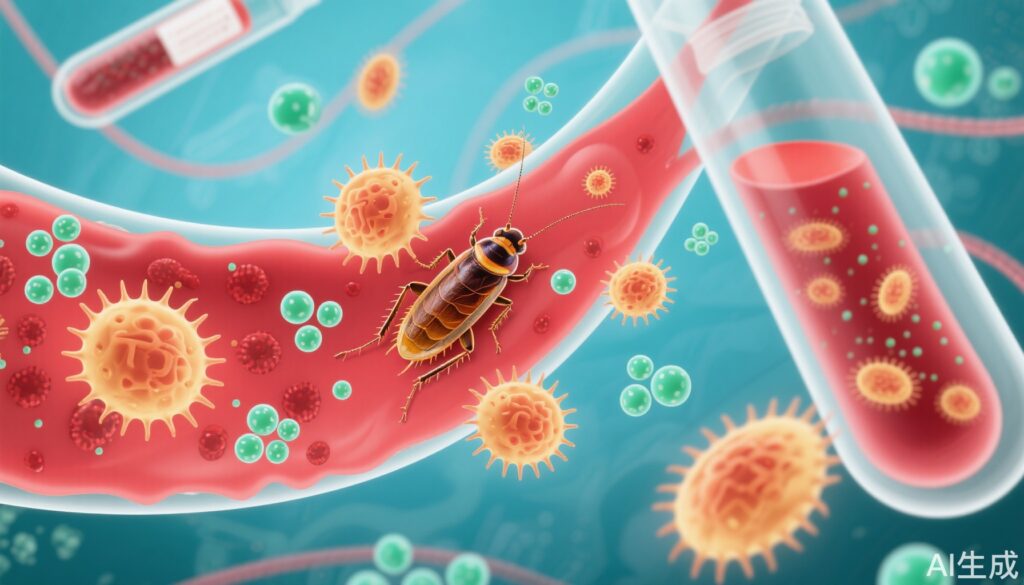Highlight
- Cockroach subcutaneous immunotherapy (SCIT) modulates immunodominant T-cell responses in children with asthma.
- Down-modulation of Th2-polarized responses occurred regardless of the abundance of specific allergens in the SCIT extract.
- Immunotherapy efficacy did not depend on extract content, suggesting broader applicability of current formulations.
- Findings may inform strategies for allergen standardization and optimization in pediatric asthma management.
Background
Cockroach allergy is a significant trigger for asthma in children, particularly in urban environments. Sensitization to cockroach allergens is associated with increased asthma severity, more frequent exacerbations, and poorer long-term outcomes. Current management includes environmental control and pharmacotherapy, but allergen immunotherapy—particularly subcutaneous immunotherapy (SCIT)—offers a disease-modifying approach. However, heterogeneity in allergen content among commercial extracts raises critical questions about the necessary components for effective immune modulation, especially as allergen quantification remains technically challenging for cockroach extracts. Understanding how T-cell responses are shaped by immunotherapy could clarify mechanisms and inform extract standardization.
Study Overview and Methodological Design
This was a randomized, placebo-controlled trial conducted in children aged 8–17 years with mild to moderate, well-controlled asthma and confirmed cockroach sensitization. Participants (n=46) were randomized to receive either cockroach SCIT (CR SCIT, n=20) or placebo (n=26) over 12 months. Peripheral blood mononuclear cells (PBMCs) were collected before and after the intervention. Investigators assessed CD4+ T-cell responses using overlapping peptide pools from 11 well-characterized cockroach allergens. Intracellular cytokine staining quantified Th2 cytokine (IL-4), Th1 cytokine (IFNγ), and regulatory (IL-10) responses. The primary endpoints were changes in the magnitude and polarization of allergen-specific T-cell responses, with secondary analyses examining immunodominance and correlation with allergen content in the administered extracts.
Key Findings
SCIT induced prominent modulation of CD4+ T-cell responses, particularly among those with the most robust and Th2-skewed baseline reactivity. Notably, a significant down-modulation was observed against Bla g 5 and Bla g 9, which were the most dominantly recognized cockroach allergens in this cohort. Importantly, the modulation of T-cell responses was observed regardless of the abundance of these allergens in the SCIT extract, indicating that even when specific allergens were present in low quantities, immunotherapy effectively targeted the dominant T-cell populations. The findings were statistically robust, with downregulation of Th2 responses (IL-4 production) and a relative shift towards regulatory and Th1 phenotypes.
Mechanistic Insights and Pathophysiological Context
T-cell responses to allergens are central to the immunopathology of allergic asthma. In this context, Th2-polarized responses (characterized by IL-4 production) drive IgE synthesis, mast cell activation, and eosinophilic inflammation. Allergen immunotherapy typically aims to downregulate these Th2 responses while promoting regulatory (IL-10) and Th1 (IFNγ) pathways. The current study demonstrates that immunodominant T-cell responses—those most actively involved in the allergic process—can be modulated even if their corresponding allergenic proteins are sparse in the therapeutic extract. This suggests the presence of high-affinity T-cell clones and/or epitope spreading, allowing for effective immune modulation without high allergen abundance. These insights challenge the paradigm that quantitative allergen representation in extracts is the primary determinant of immunotherapeutic efficacy.
Clinical Implications
For clinicians, these findings reinforce the utility of cockroach SCIT in pediatric asthma, even when extract standardization is imperfect. The data suggest that current commercial extracts—despite variability in specific allergen content—may remain clinically effective, as immunodominant T-cell populations are still targeted. This could alleviate concerns regarding extract composition and support broader implementation of SCIT in cockroach-allergic children. In practice, the study underscores the need for careful patient selection, focusing on individuals with strong Th2 polarization who may benefit most from immunotherapy.
Limitations and Controversies
Several limitations merit consideration. The study was small (n=46), limiting generalizability and statistical power for less common allergen responses. The trial focused exclusively on well-controlled, mild to moderate asthma; findings may not extrapolate to severe asthma or adults. The immunological endpoints, while mechanistically informative, do not directly address clinical outcomes such as symptom reduction or exacerbation rates. Additionally, the study’s design did not allow assessment of long-term durability of T-cell modulation beyond the 12-month period. Finally, the heterogeneity of cockroach extracts across manufacturers and geographical areas remains a concern for broader application.
Expert Commentary or Guideline Positioning
Recent guidelines from the American Academy of Allergy, Asthma, and Immunology (AAAAI) recognize cockroach immunotherapy as an evidence-based adjunct for selected patients, but emphasize the need for standardization and robust clinical endpoints. Opinion leaders have called for improved extract manufacturing and personalized approaches to immunotherapy. This study offers reassurance that current practices may be more robust than previously thought, but also highlights the need for ongoing research to optimize allergen formulations.
Conclusion
This randomized trial provides compelling evidence that cockroach SCIT effectively modulates immunodominant T-cell responses in pediatric asthma, independent of allergen abundance in the extract. These findings challenge prevailing assumptions about the criticality of allergen representation in immunotherapy products and suggest that current extracts may suffice for immune modulation. Further research should address larger, more diverse populations, longer-term outcomes, and the translation of immunological findings into tangible clinical benefits.
References
1. da Silva Antunes R, et al. Cockroach immunotherapy modulates dominant T cell responses independent of allergen extract content. J Allergy Clin Immunol. 2025 Jul 24:S0091-6749(25)00798-5. doi: 10.1016/j.jaci.2025.07.011.
2. Glesner J, et al. Standardization and optimization of cockroach allergen extracts for immunotherapy. Curr Allergy Asthma Rep. 2021;21(11):63.
3. Cox L, et al. Allergen immunotherapy: A practice parameter update. J Allergy Clin Immunol. 2011;127(1 Suppl):S1-55.



